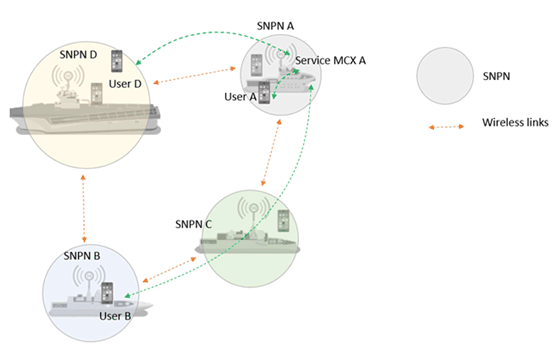Content for TR 22.848 Word version: 19.0.0
5.5 Use case on quality of service differentiation and resource prioritization in a group of interconnected standalone naval non-public networks
5.5.1 Description
5.5.2 Pre-conditions
5.5.3 Service Flows
5.5.4 Post-conditions
5.5.5 Existing features partly or fully covering the use case functionality
5.5.6 Potential New Requirements needed to support the use case
5.5 Use case on quality of service differentiation and resource prioritization in a group of interconnected standalone naval non-public networks p. 16
5.5.1 Description p. 16
This use case deals with self-organizing, broadband, low latency, connectivity solution between ships in a fleet. It is an extension of the use case 5.3 on interconnection of standalone naval non-public networks.
In this use case, several users located on different ships are involved in a real time mission critical communication while the interconnection links between the Standalone Non-Public Networks inside the group of interconnected Standalone Non-Public Networks experiences heavy load.
The situation described in this use case is depicted on the Figure 5.5.1-1 below:

Figure 5.5.1-1: Example of critical communication in a group of interconnected standalone naval non-public networks
(⇒ copy of original 3GPP image)
(⇒ copy of original 3GPP image)
5.5.2 Pre-conditions p. 17
All User Equipment are loaded with a USIM and are registered to their local SNPN.
A MCX service is available onboard ship A (called MCX A in the following section)
All users involved in the use case have needed credentials to access MCX A service.
5.5.3 Service Flows p. 17
- User A requests a real time video streaming involving a MCX server located onboard ship A to users B and D respectively located on ship B and D.
- If the requested quality of service can be reached, users A, B, D on-board ships A, B, D, and attached to the on-board SNPNs A, B, D, can establish a PDU session to access the video streaming service provided by the MCX server on ship A.
- While establishing the user B's PDU session, the 5G system identifies that communication shall be routed from SNPN A to SNPN B through SNPN C to fulfil the quality of service required by the MCX service A. The 5G system configures all resources on this path according to MCX service A's quality of service requirements.
- While establishing the user D's PDU session, the 5G system identifies that communication can be directly routed from SNPN A to SNPN D. The 5G system configures all resources on this path according to MCX service A's quality of service requirements.
- At this point in time, users A, B, D consume the real time video service hosted by the MCX server A and the 5G system constantly monitors the achieved end to end quality of service with regards to the application known requirements.
- The delivered end to end quality of service changes (due to e.g. path loss increase on the interconnection links), thus triggering a notification from the 5G system to the MCX application which decides to lower the video resolution to match the end to end connection capacity and maintain an acceptable experience for the users.
- Meanwhile, lower priority communications are setup inside the fleet and start to heavily load all the interconnection links.
- The 5G system ensure that the critical video streaming communication between users A, B, D has higher priority related to the other ongoing data exchanges which results in user A, B, D continuing experiencing a good quality MCX service A.
5.5.4 Post-conditions p. 18
Users A, B, D are attached to SNPN A, B, D and still in communication with MCX service A.
5.5.5 Existing features partly or fully covering the use case functionality p. 18
None
5.5.6 Potential New Requirements needed to support the use case p. 18
[PR 5.5.6-001]
Based on SNPN configuration and subject to SNPN operator's policy, the 5G system shall be able to support prioritization of resources for a service offered by a Standalone Non-Public Network that is consumed by users attached to other interconnected Standalone Non-Public Networks.
[PR 5.5.6-002]
Based on SNPN configuration and subject to SNPN operator's policy, the 5G system shall enable a SNPN to monitor the currently delivered end to end QoS for a service hosted by this SNPN and consumed by one or several users attached to other Standalone Non-Public Networks inside a group of interconnected Standalone Non-Public Networks.
[PR 5.5.6-003]
Based on SNPN configuration and subject to SNPN operator's policy, the 5G system shall be able to provide event notification upon detecting that the requested end to end QoS level cannot be met for a service hosted by this SNPN and consumed by one or several users attached to other Standalone Non-Public Networks inside a group of interconnected Standalone Non-Public Networks.